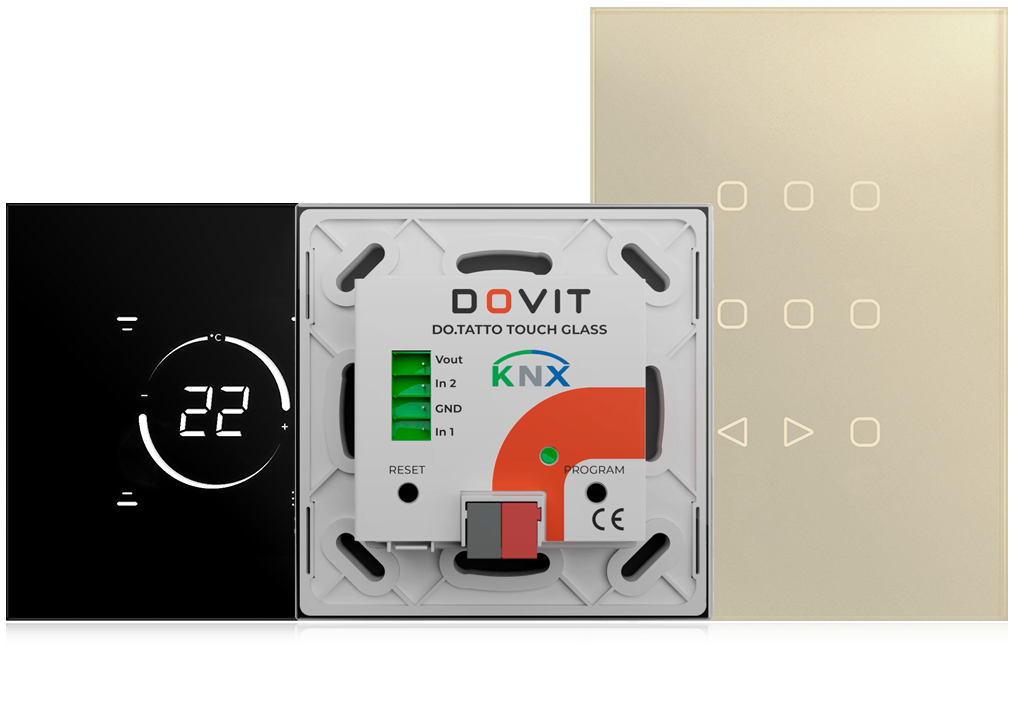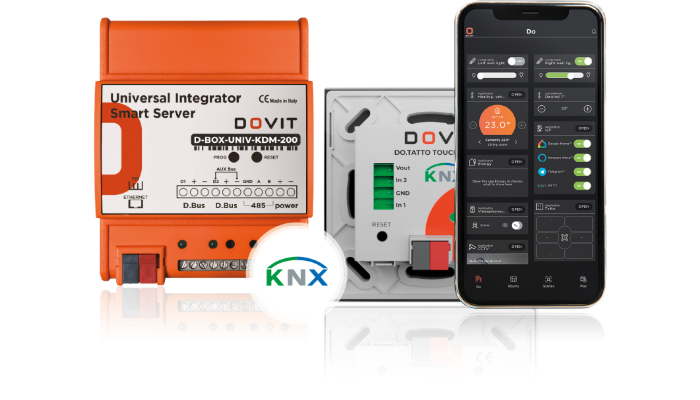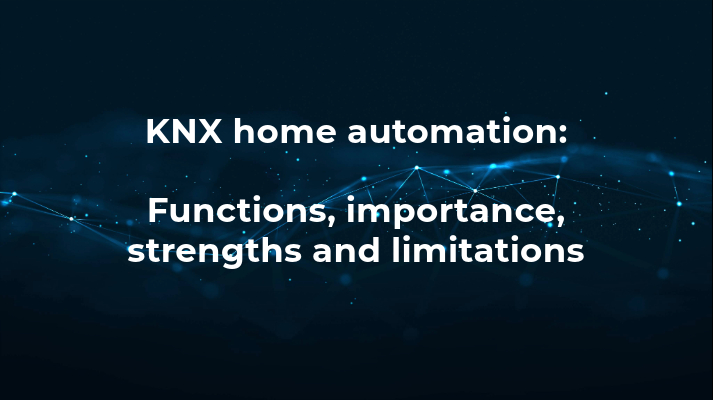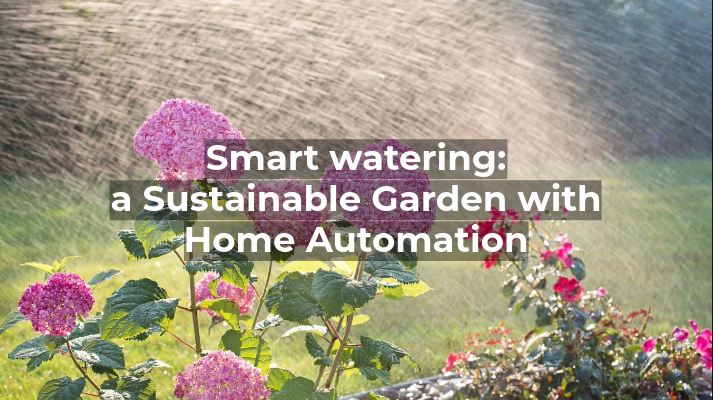Home automation has revolutionized the way we live and interact with our homes. By integrating technologies, it is now possible to manage every aspect of a Smart Home intelligently, optimizing comfort and reducing energy consumption. One of the most widespread and recognized standards in the world of Smart Homes is the KNX protocol. This article will explore what KNX technology is, why this standard is significant, and its advantages and limitations.
What stands KNX Home Automation for?
KNX is an international communication protocol standard designed for managing and controlling a home automation system within a Smart Home or Smart Building. Developed to facilitate communication between devices and technologies from different brands, KNX ensures full interoperability and allows the integration of numerous components, such as lights, blinds, heating systems, ventilation, and security systems.
Thanks to its use in over 190 countries, the KNX protocol is recognized worldwide and especially in Europe as a reference standard for the automation of residential and commercial environments. Unlike other proprietary technologies, the KNX protocol is manufacturer-independent, meaning devices from different brands can interact within a single system.
Dovit provides its customers with a complete solution, including its KNX server and touch thermostats and switches, both available in KNX versions. These devices not only guarantee maximum compatibility with the KNX standard but can also be managed through a single application. This app enables centralized and simplified management of all Smart Home functionalities: from lighting to climate control, from security to energy management.


Is the KNX protocol important for home automation?
Yes, especially for managing lighting, motorized devices (such as blinds and awnings), and zoned temperature regulation.
For more complex home automation systems, additional protocols may be needed for specific areas. For example, ModBus (along with KNX, one of the most widely used protocols on the market) is particularly suitable for energy consumption analysis, managing heating plants, photovoltaic systems, and electric vehicle charging stations.
The DALI protocol, on the other hand, is particularly suitable for lighting control..
How do different protocols communicate with each other?
Protocols require either multiple gateways to consolidate all information on a single bus (taking care to avoid bottlenecks) or a multiprotocol server (multigateway) that enables parallel data usage. A multiprotocol server offers the advantage of greater scalability, allowing the addition of new functions in the future and avoiding bottlenecks.
A home automation system relies on a network of interconnected devices that communicate with each other and can be centrally managed. The KNX protocol plays a key role in this architecture for several reasons:
- Reliability: The KNX system operates via dedicated wiring (bus), making it more stable and reliable than wireless solutions, which can be affected by interference or coverage limitations.
- Scalability: A KNX-based home automation system is easily expandable. New devices can be seamlessly integrated into the system in the future, even if they are from different manufacturers.
- Interoperability: One of the strengths of the KNX protocol is its ability to enable communication between devices from different brands within a single network. This provides greater flexibility in component selection and allows designers to create customized systems tailored to the end user’s needs.
- Energy Efficiency: KNX home automation optimizes energy consumption by integrating advanced functions such as automatic management of lighting, heating, and cooling, reducing overall energy requirements.
- Recognized Standard: The KNX-branded technology complies with international standards (EN 50090, ISO/IEC 14543) and grants quality and safety for both industry professionals and consumers.
Note: While KNX is an open protocol, it is not always the best choice for security systems. In these cases, proprietary protocols specifically designed for security applications are preferred
KNX home automation system, without KNX, or hybrid: which is best?
It depends on the functions and applications the Smart Home system must provide. If the home automation system is simple and involves a limited number of functions, a KNX system might suffice. However, for complex systems requiring diverse functionalities — such as energy consumption analysis, native alarm system control, or video surveillance — other, more suitable protocols must also be integrated.
When to choose a KNX home automation system
KNX home automation offers numerous advantages in terms of flexibility and reliability. Thanks to its open nature and ability to support devices from different manufacturers, a KNX-based system is highly scalable and versatile. Moreover, using a KNX server, such as the one offered by Dovit, allows centralized management of all system functionalities, providing a single interface for controlling lighting, climate, security, and more.
When to choose a non-KNX or hybrid home automation system
A home automation system that does not support the KNX protocol may be limited in terms of interoperability and scalability. Many proprietary home automation solutions rely on closed protocols, restricting device selection and complicating the integration of new components.
A hybrid system, combining protocols like KNX, ModBus, DALI, and others, is often the most suitable choice. If the system must manage various functions (lighting, climate control, security, energy management) with specific requirements, a hybrid solution allows the best protocol for each function to be adopted.
In summary, a hybrid system is particularly suitable for complex projects, future extensions and situations where different technologies need to be integrated. By using a multi-protocol integration server, such as Dovit’s, it is possible to simplify management and benefit from the advantages of each protocol, ensuring a robust, scalable and highly customisable system.
What is the role of a server in home automation?
A home automation system does not necessarily need a server. A system based exclusively on a communication bus, as in the case of KNX, allows devices to communicate directly with each other via a dedicated network. Each device sends and receives messages on the bus in a decentralised manner, without the need for a central server.
With many devices or gateways, all data must travel over the bus. If the traffic becomes too heavy, there is a risk of a general slowdown or failure of some communications. Complex functions, such as the integration of multiple protocols (e.g. KNX with ModBus or DALI), advanced energy management, or real-time data analysis, cannot be easily implemented on a simple bus.
Therefore, when a home automation system is complex, includes many functions, different protocols and the possibility of communicating between devices, or between the home automation system and the user (via apps or interfaces), then an integration and supervision server becomes necessary.
The server allows the centralisation of the management of all devices connected to the system, offering a single interface to control all functionalities. The Dovit KNX server, for example, not only manages KNX devices, but can also integrate other standards and protocols, making centralised management of the entire Smart Home possible.
The use of a Dovit server also guarantees greater security, as all information and data of the home automation system remains localised in the user’s own server, avoiding dependence on external cloud services. This means that the system works even in the event of Internet connection interruptions, and even without a cloud, if you want to maintain maximum security and confidentiality, guaranteeing operational continuity.
Dovit also offers an integration server that is born with different protocols (e.g. KNX, Dali, BACnet, Modbus, Zigbee and many others) that integrates with countless technologies. Therefore, this multi-protocol or multigateway server can be included in different installation types. The system is scalable and without brand or protocol constraints, guaranteeing fast, reliable and secure connections and centralised management in a single app.
Conclusion
If you are considering which protocol to integrate into your Smart Home, take into account the complexity of the installation, the desire for future modifications, and the possibility of combining different protocols via multi-protocol servers, such as the Dovit server, which allows both ModBus and KNX to communicate within the same interface. Thanks to solutions such as the Dovit KNX server and the Dovit integration server, it is possible to realise an advanced home automation system that meets all current and future requirements while guaranteeing security.
If you are planning to realise your Smart Home based on KNX technology, it is essential to turn to specialists in the field, such as designers, integrators and certified installers.









